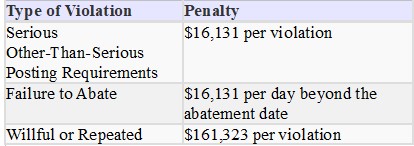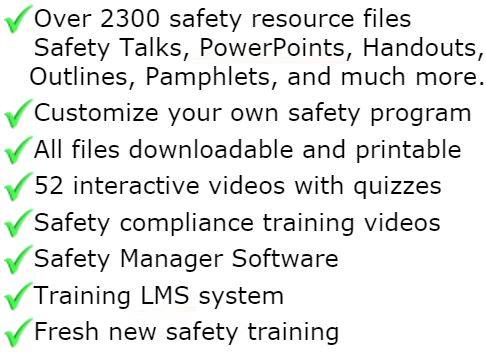
Hand Tool Safety Rules
This is a sample or partial document
Download the full customizable and printable version
1. Carry all sharp tools in sheath or holsters.
2. Tag worn, damaged or defective tools "Out of Service" and do not use them.
3. Do not use a tool if the handle surface has splinters, burrs, cracks or splits .
4. When handing a tool to another person, direct sharp points and cutting edges away from yourself and the other person.
5. Do not carry sharp or pointed hand tools such as probes or knives in your pocket unless the tool or your pocket is sheathed.
6. Do not perform "make-shift" repairs to tools.
7. Do not throw tools from one location to another or from one employee to another.
8. Transport hand tools only in tool boxes or tool belts.
Hammer Safety
1. Use a claw hammer for pulling nails and for driving nails.
2. Do not strike nails or other objects with the "cheek" of the hammer.
3. Do not strike one hammer against another hammer.
4. Do not use a hammer, screwdriver, file, etc., if your hands are oily, greasy or wet.
Power Drill Safety
1. Use brushes or vacuum machinery to remove metal chips, shavings and other debris from the drill table. Do not use your bare hands.
2. Do not use dull, cracked or bent drill bits.
Power Saw Safety
1. Keep control of saws by releasing downward pressure at the end of the stroke.
2. Do not use a saw that has a dull blade.
3. Oil saw blades after each use of the saw.
4. Keep your hands and fingers away from the saw blade while you are using the saw.
5. Do not carry a saw by the blade.
Hand Files & Rasp Safety
1. Do not use a file as a pry bar, hammer, screwdriver or chisel.
2. When using a file or a rasp, grasp the handle in one hand and the toe of the file in the other.
3. Do not hammer on a file.
Chisel Safety
1. Use a chisel that has been sharpened; do not use a chisel that has a dull cutting edge.
2. Hold a chisel by using a tool holder if possible.
3. Clamp small work pieces in the vise and chip towards the stationary jaw when you are working with a chisel.
Tool Boxes, Tool Chests & Cabinets
1. Use the handle when opening and closing a drawer or door of a tool box, chest, or cabinet.
2. Tape over or file off sharp edges on tool boxes, chests or cabinets.
3. Do not stand on tool boxes, chests or cabinets to gain extra height.
4. Lock the wheels on large tool boxes, chests or cabinets to prevent them from rolling.
5. Push large chests, cabinets and tool boxes; do not pull them.
6. Do not open more than one drawer of a tool box at a time.
7. Close and lock all drawers and doors before moving the tool chest to a new location.
8. Do not use a tool box or chest as a workbench.
9. Do not move a tool box, chest or cabinet if it has loose tools or parts on the top.

GET INSTANT ACCESS
to THE MEMBERS LIBRARY
Safety materials created by safety professionals.
Access to the Safety Manager software.
Wide variety of safety videos and courses.
**Brand New** Safety Training Management System
Pre-Made Safety Materials Ready For Use
Created by experienced safety professionals & risk consultants. Saving you time, money, and risk of injuries.
95% of the work already done.
Below are the maximum penalty amounts, with the annual adjustment for inflation, that may be assessed after Jan. 15, 2024. (See OSHA Memo, Jan. 8, 2024).

**New OSHA HEAT 90 DAY**
>>Download Free HERE<<
**New 2024 OSHA 300 Form**
>>Download Free HERE<<
**Brand New**
Free with full membership subscription
Training LMS System
Ask The Safety Consultant
Safety Equipment Deal Finder

“SafetyInfo.com is the first go-to website for safety professionals and companies to use in establishing a solid safety program"
-Mike McKenzie, Certified Safety & Health Manager (CSHM), McSafety Solutions™
Note: You must have a full subscription to the Safety Library in order to use this material. Any use outside of your organization, for resell, or without an active membership is strictly prohibited and may result in prosecution under copyright infringement laws. Please contact us first, if you would be interested in reselling or using our materials for reproduction.
Inside the Members Library
Topic Index
Accident Prevention
Air Quality
Asbestos
Bloodborne Pathogens
Boilers
Chemical Safety
Compressed Gas
Confined Space
Construction
Construction Worksite
Cranes & Slings
Driver / Fleet Safety
Drug Free Workplace
Electrical
Emergency Management
Engineering Safety
Environmental
Equipment
Ergonomics
Fall Protection
Fire Safety & Prevention
First Aid
Flammable Materials
Forklifts
Hazard Communication
Hazardous Materials
Hearing Protection
Heat Stress
Hot Work
Housekeeping
Job Safety Analysis
Laboratory
Ladders
Lead
Lockout-Tagout
Machinery & Equipment
Material Handling
MSDS (SDS)
Medical & First Aid
Occupational Health
Office Safety
Off the Job Safety
Personal Protection
Process Safety
Record Keeping
Respiratory Protection
Silica Safety
Rules & Policies
Signs & Labels
Slips, Trips & Fall
Training
Terrorism Programs
Tool Safety
Vehicle & Driver
Violence Programs
Welding & Hot Work
Training Videos
Library Index
Training Materials
Videos/Courses
Talks
Articles
PowerPoint
Handouts
Training Overheads
Quizzes
Supervisor Briefs
Management Briefs
Safety Sessions
2 Minute OSHA Safety Talks
Pamphlets
First Aid Training
Supervisor Training
Hazardous Materials
Bomb Threat
Crossword Puzzles
Biological Agents
Forms & Documents
Forms
Checklists
Audit Guides
Inspections Guides
Signs & Labels
Environmental Audit Guides
Recordkeeping - OSHA 300
Sign & Label Maker
Safety Management Resources
Safety Manuals/Written Programs
Ergonomic Programs
Emergency Plans
Process Safety Management
Construction Safety
Occupational Health
Environmental
Topic Sheets
DOT Fleet-Driver
Hazardous Materials
Chemical Safety
Drug Free Workplace
Terrorism Programs
Development Guides
Safety Manager Software
Safety References & Graphics
Technical Safety Information
Posters
Topic & Fact Sheets
Development Information
Job Specific Safety Rules
Terrorism
Calculators
Safety Comic Strips
New Safety Training System
Schedule and train your employees with our materials. Add unlimited amount of employees. Record all progress and issue certificates. For group and individual training sessions.

